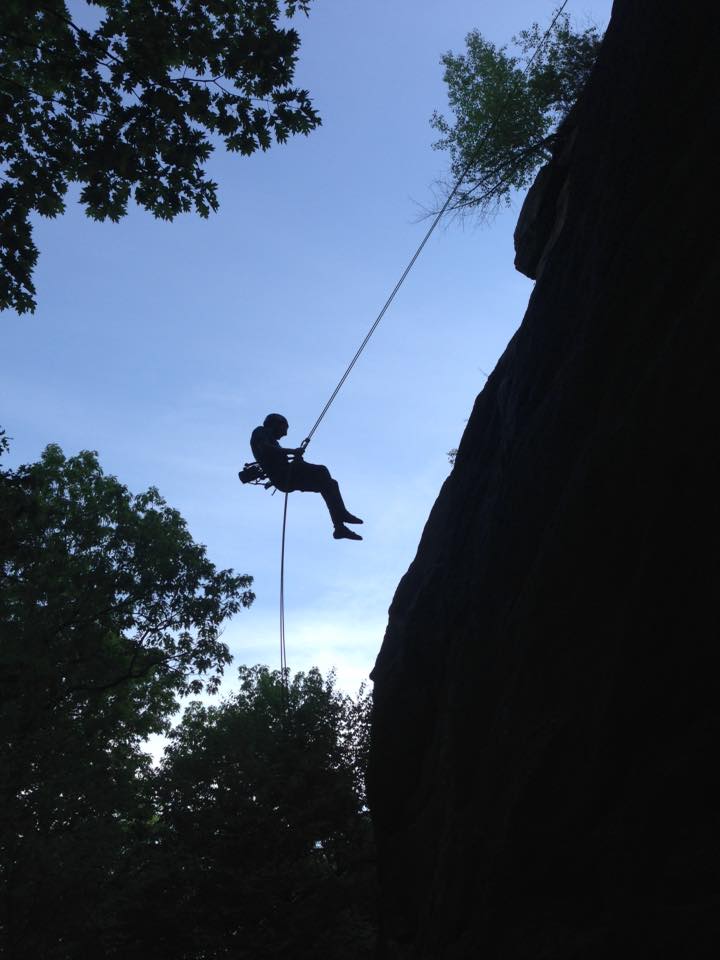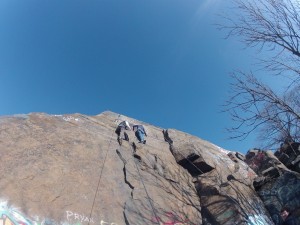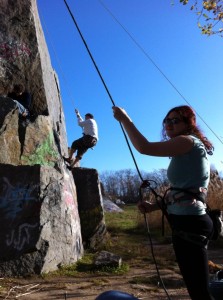
You know those exercises where you fall back into a partner’s arms and trust that he or she will catch you? What if that person is a family member, like a 16 year old daughter, or 18 year old son?
Do you trust them? What if your relationship is on the rocks? Literally!
Our family spent Thanksgiving rock climbing, outdoors, at a local quarry. I like to think of it as complex cliff climbing; though for experts like my kids, the 50-75 foot climbs were mere child’s play.
There’s a lot to learn about trust when rock climbing. For example, see this three part series in July, 2012 “Three Things You Need to Know about Trust” by Charlie Green. Three distinct topics emerged:
- Trust is a Two-player Game
- Trust Requires Risk
- Trust is Reciprocal

As Charlie notes: one party must do the trusting, and the other party must be trusted. That is true in business and personal life, as well as in climbing. And it’s risky. All involved must trust each other in order to do well, be safe and have fun.
In rock climbing, if the rope isn’t secure at the top of the cliff – well, I don’t want to go there. So the climber must trust the one who secures the rope. That person must be credible, one of the elements of the Trust Equation.
Climbers might be comfortable climbing on the ropes they set themselves. I, for one, am not yet experienced enough to know what a secure top rope should even look like. However, I do know my kids who secured the ropes. They are careful, and take calculated risks. They learn before they do, and they learn from people who know what they are doing. So I simply trust that it will be done right. And I don’t worry about it. How often do we do that in business? In life?
Top rope rock climbing is about more than trusting that the foundation is secure. It’s trusting that the partner belaying (anchoring and holding the rope at the bottom) you will not let you fall. And it’s reciprocal. When there are only two of you, you have to belay the person who belays you.
Remember the trust fall exercise? Try this: imagine you are 50+ feet high on a rock wall with a 90 degree slope, and the only thing between you and a hospital bed is your 16 year-old daughter.
As I leaned back, I worried needlessly about whether the fact that I weighed a lot more than her would send her flying off the ground if I fell. After all, she wasn’t secured to the ground. At one point while I was descending, she wasn’t even watching – just feeling the tension on the rope and releasing it at just the right speed so I could safely descend the cliff until I reached the bottom.
I belayed for her climb next. She didn’t worry about anything. She tried something. It did not work. She fell and trusted that I would catch her. And I did. Several times. Once when she dropped a little further than she would have liked, I got the “how did that happen?” look from her. But she trusted it wouldn’t happen again. And it did not.

By trusting her, and her trusting me, we strengthened our bond. We knew we wouldn’t let the other get hurt, and we got to prove it a few times. It kind of made us reliable. This was repeated with each of my other kids as well. Among all of us, I was the least trusting – and they knew it.
I had difficulty with one of the climbs – all right, all of the climbs. But on one of them, my kids gave me sage advice. “Just trust that you can do it.” “It will be ok.” “Take a risk.” “Try it – we don’t know what will work either until we do it.” “Commit.” “The worst that will happen is you will fall and I will catch you.“
They had me on the last one. And each of them was very reliable. After all, I got home safely and could write this.
Next time, I will practice trusting even more. Because the more I can let go of fear and just trust that it will work out, the better I will do, the more I will be able to do, and the more I will enjoy it. And with rock climbing, with my kids, the more I trust them, the more we connect, bond, and appreciate each other.
Funny thing. Doesn’t that apply to most everything in life and in business?
